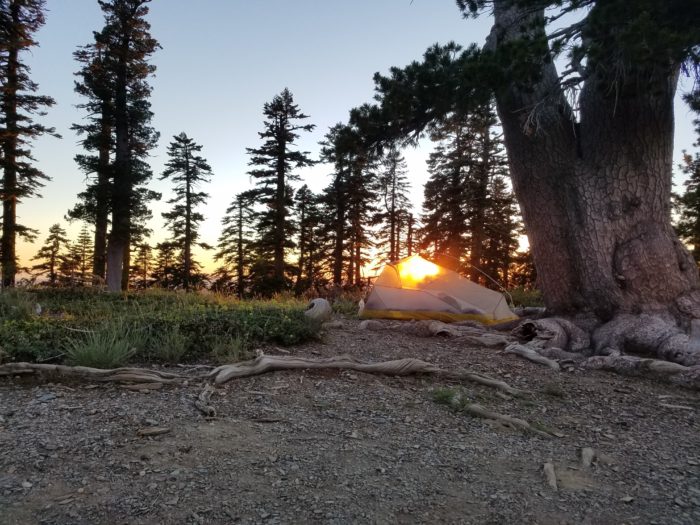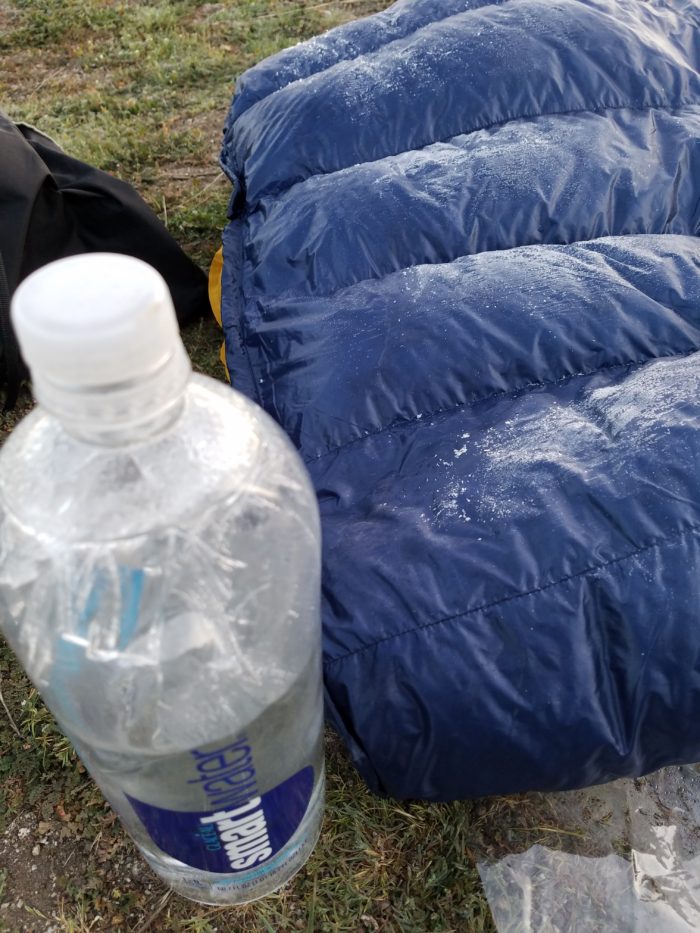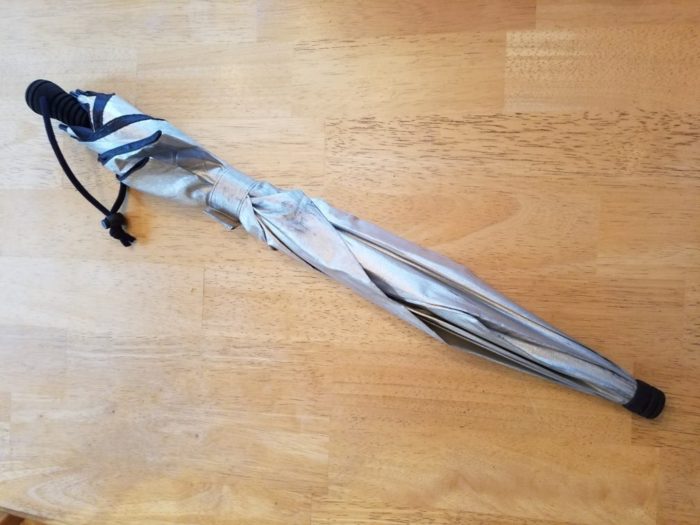A lot of people have asked me about gear – how many pairs of shoes did I go through, did my tent leak, how was my backpack, that sort of thing. Here’s a list of the main pieces, along with some smaller trinkets which helped me along my way. One thing I discovered during the trip was how many people consider gear as single-hike (or even half-hike) disposable. For instance, a popular brand of ultralight gear warranties its stuff for “one 2500 mile thruhike”. People are willing to pay for, and toss, gear, if it’s super lightweight and helps them get to Canada.
I’m not in that group. I’m also not someone who counts every ounce, i.e. a “gram weenie”. For me, gear has to work first, and be lightweight second. I also don’t buy knock-off gear. There’s a large group of folks out there who will buy stuff off Alibaba that’s clearly clones of a popular gear, or produced somewhere with zero environmental regulations, or something cheap and disposable (see above). I like stuff that lasts.
Smokebeard Seal of Approval
Backpack
Osprey Exos 58, size L. The older (good) model, with the hip and shoulder strap pockets.
Loved it. I started without the “brain” or upper part that adds several liters of capacity; I just didn’t need it. The pack was basically too big, BUT, the frame fit me, and I needed the overall weight carrying capacity several times. Size-wise, the 48L would have been fine. Many people make do with less. In some desert stretches I carried a lot of water, and in the Sierra I carried a lot of food. When I added cold weather and other gear in Washington the extra weight capacity again came in handy. A lot of people wouldn’t carry this pack because it’s so heavy, at 2.7 lbs. I ended the trip with a few holes torn in the outside mesh pocket, a result of me putting the pack down on rocks or against prickly trees.
Tent
Big Agnes Fly Creek UL2
Loved it. Started with just fly, poles, and a lightweight cord setup I used to tension the poles so that they could be set up without the tent. This let me leave the 1+ lb tent body home. In Spring, in the desert, there’s no bugs, so why carry the weight? I ended up getting the tent body sent to me pretty early on, as pitching it in the wind without the body to anchor it was annoying. I ended up with 2 small holes, 1 in the door, and 1 in the bottom, both of which were clearly from abuse. A little Gorilla tape and they were fine.
Sleeping bag
Not a true sleeping bag, but the Enlightened Equipment Revelation 20 degree quilt. I was only cold a few times, and 90 percent of that was due to me not snapping/zipping/buttoning up the quilt properly. I’d wake up cold in the morning and think, “man, I should have buttoned up the quilt”. For me, a 20 degree bag/quilt was good on the PCT, but then again I think we had average weather. Your mileage may vary. Whatever quilt you choose, make sure you attach it properly to your pad, and zip it up properly, if you want it to keep you as warm as possible.
Loved it. I woke up several times after cowboy camping with ice on the top of the quilt. Since I didn’t die overnight, I’m giving the quilt the credit for keeping me warm.
Sleeping pad
Thermarest Neoair X-Lite, full length. Everyone complained that they made crinkly noises, but each night I was so tired that when I closed my eyes, I fell asleep. I never got a full night’s sleep at any point on the trail, but I’m not sure it was the fault of the pad. Or quilt. I think the lack of a proper pillow played the biggest role there. Later in the trip I put my pack at the foot of my tent and rested the pad on it, to alleviate my plantar fasciitis, so I’m thinking a 3/4 length might have worked as well.
It mostly worked. It leaked, but so did everyone’s. Most people spent an hour in a hotel bathroom, holding their pad under water in the tub to find the bubbles. I couldn’t find the hole in mine, and I didn’t have the patch kit for it anyway. I just re-inflated it once or twice a night.
Shoes & Socks
5 pairs of Altra Lone Peak 3.5. I wore a combination of Darn Tough short socks and Injinji hiking socks, switching completely to the DTs once it was clear that Injinji’s don’t hold up – at least for me. I wore the Altras about 500 miles each, only wearing the sole down on the pair that went through the Sierra. The rest I swapped out when they felt bad, although even new ones only felt “good” for a day or two. I’m still on a quest for a shoe and sock combo that lets me hike without pain in every step.
Over 600 miles on the old pair (pictured on left).
Great shoes. I hear the 4.0 version is very different, so definitely look around.
Cooking
MSR Pocket Rocket, Evernew titanium pot, Gossamer Gear bamboo spoon.
Loved all three. I only carried the stove for the Sierra and then the north half of Oregon and beyond. Even in the Sierra, the only reason I carried it was to forestall a hypothermia situation if someone went in the drink crossing a river. This never happened, so it was just extra weight, although it is nice to have a warm meal now and then. I think any titanium pot that fits your food is fine, and my bamboo spoon was nice and lightweight, and also didn’t involve a massive industrial process to produce. Most people had titanium sporks, which I felt was unnecessary.
I usually carried the medium-sized, 8 oz. can of fuel (13 ounces full), since the 4 ounce can was a waste of steel in my opinion. Nowhere did I see the special tool needed to “pop” the cans so that they’re safe to recycle. Towards the end when fuel was getting hard to find in stores, I’d just grab half-full 8oz cans from hiker boxes. Weight snobs would burn half of them, then dump them and get new cans, rather than carry both cans in order to burn up all the fuel.
Clothes
I wore the same clothes every day. Yes, it got gross after a while. I had a separate “town” shirt that I slept in once or twice when my main shirt was just too wet or too foul. I started off with my “Get Dirty” wicking T and an REI longsleeve shirt along with REI sahara pants. Even in the desert, I tried to walk fully covered. I had an old random Patagonia base layer top and bottom that I used for sleeping when cold.
The pants finally blew out, since they had 100s of miles on them from last year, and before. I replaced them with Ex Officio bugproof pants – very nice. One thing I love is the zipoff zippers are different colors, so you never grab the wrong leg to try and mate with the wrong side shorts. I got an Ex Officio bug shirt for Sierra and north. I never needed bug spray with the bug clothes, and scarf wrapped around my head.
Baseball hat. A lot of people, mostly the ultralight crowd, tended to wear all-around hats, especially straw ones. It seemed part of the uniform. My old Marmot hat has been with me for a long time, so it was fitting that I wore it all the way to Canada. In the end, it was pretty dirty and gross, but so was I.
My Shemagh – it’s like the Hitchhiker’s towel – scarf, turban, hostel towel, sarong, anything. Yes, 6 ounces, no, it’s not a “pack towel”, but you also look way cool.
On the PCT, cotton doesn’t kill the way it does in the East, but I’d still stay away from it if I could. The poly/cotton bugshirt got wet more than once from sweat. Other than that, comfort is king. Definitely go with some wicking underwear, to help avoid chafing. I also found more chafing with the poly/cotton blend shirt than with pure poly.
Health and beauty
The Deuce of Spades poop shovel – I liked it and felt like an ultralight hipster, but it performed poorly north of Sierra due to roots, rocks, and thin soil. It was hard to get a proper cathole.
Flagyl (aka Metronidazole) – I never needed it, but was glad to have it. Nothing sucks more than having explosive Giardiasis. You’ll need to get this from a doctor.
Baby wipes – yes and more yes. Always carry a resealable pack of baby wipes. And use them to clean up before getting a hitch; you’ll set a better example for the rest of us.
Bug dope – I never used any. At all.
Sunscreen – I had a little 1 ounce tube of SPF30 that I kept in a shoulder strap pocket. I only used it in the Sierra to cover my nose and cheeks. The full beard really helps here, as did my shemagh. In the desert, I was wrapped up the whole time, except for early morning or late in the day when the sun angle was low. This stuff you can find in any drug store. Your requirements may differ from mine.
ENGO blister patches – these were a literal gamechanger for me. I had almost no blisters on the balls of my feet, they only popped up when these patches wore out.
My old trusty first aid bag, with bandaids, antibiotic ointment, Leukotape, Immodium and gauze. Some people carried a small baggie with just 1 or 2 bandaids to save weight, I felt it was worth it to be prepared. For Washington I added a 200-count bottle of Advil, and took 4 each night before sleep.
Miscellaneous Gear
Polycro groundcloth – too small, but otherwise great. I had cut it small for cowboy camping and use under just my tarp. When I pitched the tent on top of it, the sides of the tent floor got wet. Still, it weighed almost nothing and packed small. I saw no advantages to this over Tyvek, and it was a heck of a lot lighter.
Lawson Ti stakes -No problems with them at all, even hammering them in, and a great upgrade over aluminum stakes at half the weight.
Nylofume plastic bag liner for pack – no leaks, weighed almost nothing. Loved it.
Cascade Designs Carbon Fiber treking poles –
Great and cheap, no problems at all except for wear. Cascade Designs replaced lower sections when they wore down after 900 miles, which I thought was pretty awesome.
Chromedome – life’s better under the dome. Get the 8 ounce, real sized one. Don’t be tempted to chintz out on the mini or ultralight one. Also, they all break, the trick is to be crafty with your broken one as you move forward. Some mornings in the desert I was “under the dome” by 8am. And it’s also an umbrella, which was awesome when I had to hike all day in the rain.
Electronics
Petzl Aktik Core headlamp – a light for when all others go out. This headlamp rocked; huge battery capacity and Death Star-like power when set to full. Only my headlamp was needed on our big nighthike of the Aquaduct. Everyone just walked alongside with theirs off. I nighthiked 3 times, and this thing made it easy. After seeing it, other people said, “wow, my headlamp sucks”.
S7 Active phone – amazing phone, epic battery life, built-in shock proof case, waterproof. It survived the whole way and people remarked on the camera quality.
Anker 5000 and 10000
I started with the 5000 and then switched to the 10000 for the Sierra, since I knew I wouldn’t have power for over a week. I never ran out. Hipster hikers will probably choose a no-name brand and no-name charger if they’re half an ounce lighter, but the 5000 was rubber coated and pretty rugged, and the 10000 had an aluminum case. This is important because they can burst into flames if damaged, as my friend Cherry Bomb discovered outside of Big Bear. Anker claims hers lit on fire because it was dropped – hard to confirm, but aluminum is definitely better than plastic here. Between the phone, brick and charger I was carrying a pound of electronics. Not ideal, but I didn’t see a way around it.
Not electronics – but I carried paper maps and the pages from the 2016 Yogi book. I found the paper maps educational and interesting, and actually needed them when we were on snow up in the mountains. When there’s no visible trail, or worse, 10 visible trails of footprints in the snow, you need to actually refer to topology to figure out where you’re supposed to go. The town maps from the Yogi book were awesome; great to get a hitch in and know where the camping/shower/beer/grocery was.
Final thoughts
People make a big deal about gear. Mostly its weight. My philosophy was to try and carry functionally equivalent gear that was as light as possible, without spending frivolously. There’s a diminishing return as you get lighter and lighter, relative to the cost. As Guy Waterman once wrote in his book (I think) Wilderness Ethics, “if you can pick up a pack, you can carry it all day with the right attitude”. I didn’t sweat every ounce, and in fact enjoyed watching the anguish of the ultralight guys when I mentioned pack weight or how much water I carried. I also made the conscious decision to be comfortable, for instance to carry items like the umbrella and scarf.
Gear is not what’s going to get you to Canada. Thru-hiking is 90 percent mental, and the other half is physical. Good gear definitely helps though; it can be a huge morale killer to hike or sleep in wet clothes, or to wake up cold every night, or get sunburned, or get devoured by mosquitoes. A lot of people, some famous, have done long distance hikes with really cheap, non-fancy gear. What’s important is your choice to be comfortable with it.









One Comment
Comments are closed.